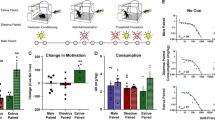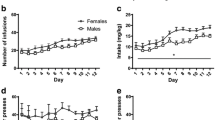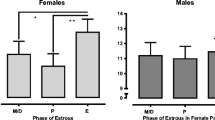Abstract
Rationale
Gender differences exist in the patterns of drug taking in cocaine addiction, suggesting that the propensity to relapse varies between men and women. Previous reports have shown sex differences in both cocaine-primed and conditioned-cued reinstatement of cocaine-seeking behavior, including recent evidence that the estrous cycle influences the level of conditioned-cued reinstatement. However, the influence of the estrous cycle on cocaine-primed reinstatement has not been examined.
Objective
Accordingly, we assessed the influence of sex and estrous cycle status on cocaine-primed reinstatement of drug-seeking behavior in Sprague–Dawley rats.
Methods
Intact male and female rats were trained to lever press to self-administer intravenous cocaine (0.5 mg/kg every infusion; fixed ratio 1, 20-s time-out following each infusion), followed by prolonged extinction training, and subsequently tested for the ability of a cocaine-priming injection (0, 5, or 10 mg/kg i.p.) to reinstate extinguished cocaine seeking (i.e., nonreinforced lever responding).
Results
Despite no differences in cocaine intake between male and female rats, females responded more on the cocaine-paired lever during self-administration and extinction relative to males. Subsequently, both males and females exhibited a dose-dependent cocaine-primed reinstatement of extinguished drug-seeking behavior. Moreover, females in estrus exhibited significantly higher reinstatement than either males or non-estrus females, following a high-dose (10 mg/kg) cocaine prime.
Conclusions
Estrus females display heightened sensitivity to the motivational and/or stimulant effects of cocaine, suggesting that hormonal state modulates drug craving and propensity for drug relapse in cocaine addicts.


Similar content being viewed by others
References
Alleweireldt AT, Hobbs RJ, Taylor AR, Johnson JA, Neisewander JL (2004) Infusions of the D1 receptor antagonist, SCH-23390, into caudal subregions of amygdala and striatum modulate cocaine self-administration and cocaine-seeking behavior in rats. Society for Neuroscience Abstracts, p 12
Becker JB, Cha JH (1989) Estrous cycle-dependent variation in amphetamine-induced behaviors and striatal dopamine release assessed with microdialysis. Behav Brain Res 35:117–125
Berridge KC, Robinson TE (1998) What is the role of dopamine in reward: hedonic impact, reward learning, or incentive salience? Brain Res Brain Res Rev 28:309–369
Brady KT, Randall CL (1999) Gender differences in substance use disorders. Psychiatr Clin North Am 22:241–252
Caine SB, Bowen CA, Yu G, Zuzga D, Negus SS, Mello NK (2004) Effect of gonadectomy and gonadal hormone replacement on cocaine self-administration in female and male rats. Neuropsychopharmacology 29:929–942
Craft RM, Stratmann JA (1996) Discriminative stimulus effects of cocaine in female versus male rats. Drug Alcohol Depend 42:27–37
Dalton JC, Vickers GJ, Roberts DC (1986) Increased self-administration of cocaine following haloperidol: sex-dependent effects of the antiestrogen tamoxifen. Pharmacol Biochem Behav 25:497–501
de Wit H, Stewart J (1981) Reinstatement of cocaine-reinforced responding in the rat. Psychopharmacology (Berl) 75:134–143
Elman I, Karlsgodt KH, Gastfriend DR (2001) Gender differences in cocaine craving among non-treatment-seeking individuals with cocaine dependence. Am J Drug Alcohol Abuse 27:193–202
Evans SM, Haney M, Foltin RW (2002) The effects of smoked cocaine during the follicular and luteal phases of the menstrual cycle in women. Psychopharmacology (Berl) 159:397–406
Feder HH (1981) Estrous cyclicity in mammals. In: Alder NT (ed) Neuroendocrinology of reproduction. Physiology and behavior. Plenum, New York, pp 280–290
Festa ED, Quinones-Jenab V (2004) Gonadal hormones provide the biological basis for sex differences in behavioral responses to cocaine. Horm Behav 46:509–519
Fiorentine R, Anglin MD, Gil-Rivas V, Taylor E (1997) Drug treatment: explaining the gender paradox. Subst Use Misuse 32:653–678
Fuchs RA, See RE (2002) Basolateral amygdala inactivation abolishes conditioned stimulus- and heroin-induced reinstatement of extinguished heroin-seeking behavior in rats. Psychopharmacology (Berl) 160:425–433
Fuchs RA, Tran-Nguyen LT, Specio SE, Groff RS, Neisewander JL (1998) Predictive validity of the extinction/reinstatement model of drug craving. Psychopharmacology (Berl) 135:151–160
Fuchs RA, Allison-Evans K, Mehta RH, Case JM, See RE (2005) Influence of sex and estrous cyclicity on conditioned cue-induced reinstatement of cocaine-seeking behavior in rats. Psychopharmacology (Berl) (in press)
Glick SD, Hinds PA (1984) Sex differences in sensitization to cocaine-induced rotation. Eur J Pharmacol 99:119–121
Goeders NE (2002) The HPA axis and cocaine reinforcement. Psychoneuroendocrinology 27:13–33
Griffin ML, Weiss RD, Mirin SM, Lange U (1989) A comparison of male and female cocaine abusers. Arch Gen Psychiatry 46:122–126
Grimm JW, See RE (1997) Cocaine self-administration in ovariectomized rats is predicted by response to novelty, attenuated by 17-beta estradiol, and associated with abnormal vaginal cytology. Physiol Behav 61:755–761
Haney M, Maccari S, Le Moal M, Simon H, Piazza PV (1995) Social stress increases the acquisition of cocaine self-administration in male and female rats. Brain Res 698:46–52
Hu M, Becker JB (2003) Effects of sex and estrogen on behavioral sensitization to cocaine in rats. J Neurosci 23:693–699
Hu M, Crombag HS, Robinson TE, Becker JB (2004) Biological basis of sex differences in the propensity to self-administer cocaine. Neuropsychopharmacology 29:81–85
Kalivas PW, McFarland K (2003) Brain circuitry and the reinstatement of cocaine-seeking behavior. Psychopharmacology (Berl) 168:44–56
Kandel DB, Warner MPP, Kessler RC (1995) The epidemiology of substance abuse and dependence among women. In: Roman AB, Wetherington CL (eds) Drug addiction research and the health of women. US Department of Health and Human Services, Rockville, MD, pp 105–130
Kosten TA, Gawin FH, Kosten TR, Rounsaville BJ (1993) Gender differences in cocaine use and treatment response. J Subst Abuse Treat 10:63–66
Kosten TA, Sanchez H, Zhang XY, Kehoe P (2004) Neonatal isolation enhances acquisition of cocaine self-administration and food responding in female rats. Behav Brain Res 151:137–149
Ledford CC, Fuchs RA, See RE (2003) Potentiated reinstatement of cocaine-seeking behavior following d-amphetamine infusion into the basolateral amygdala. Neuropsychopharmacology 28:1721–1729
Lynch WJ, Carroll ME (1999) Sex differences in the acquisition of intravenously self-administered cocaine and heroin in rats. Psychopharmacology (Berl) 144:77–82
Lynch WJ, Carroll ME (2000) Reinstatement of cocaine self-administration in rats: sex differences. Psychopharmacology (Berl) 148:196–200
Lynch WJ, Taylor JR (2004) Sex differences in the behavioral effects of 24-h/day access to cocaine under a discrete trial procedure. Neuropsychopharmacology 29:943–951
Lynch WJ, Taylor JR (2005) Decreased motivation following cocaine self-administration under extended access conditions: effects of sex and ovarian hormones. Neuropsychopharmacology
Lynch WJ, Arizzi MN, Carroll ME (2000) Effects of sex and the estrous cycle on regulation of intravenously self-administered cocaine in rats. Psychopharmacology (Berl) 152:132–139
Lynch WJ, Roth ME, Mickelberg JL, Carroll ME (2001) Role of estrogen in the acquisition of intravenously self-administered cocaine in female rats. Pharmacol Biochem Behav 68:641–646
McCance-Katz EF, Carroll KM, Rounsaville BJ (1999) Gender differences in treatment-seeking cocaine abusers—implications for treatment and prognosis. Am J Addict 8:300–311
McFarland K, Kalivas PW (2001) The circuitry mediating cocaine-induced reinstatement of drug-seeking behavior. J Neurosci 21:8655–8663
McKay JR, Rutherford MJ, Cacciola JS, Kabasakalian-McKay R, Alterman AI (1996) Gender differences in the relapse experiences of cocaine patients. J Nerv Ment Dis 184:616–622
Meil WM, See RE (1996) Conditioned cued recovery of responding following prolonged withdrawal from self-administered cocaine in rats: an animal model of relapse. Behav Pharmacol 7:754–763
Neisewander JL, O'Dell LE, Tran-Nguyen LT, Castaneda E, Fuchs RA (1996) Dopamine overflow in the nucleus accumbens during extinction and reinstatement of cocaine self-administration behavior. Neuropsychopharmacology 15:506–514
O'Brien C (2001) Drug addiction and drug abuse. In: Hardman J, Limbird L, Gilman AG (eds) The pharmacological basis of therapeutics. McGraw-Hill, New York, pp 621–642
Quinones-Jenab V, Ho A, Schlussman SD, Franck J, Kreek MJ (1999) Estrous cycle differences in cocaine-induced stereotypic and locomotor behaviors in Fischer rats. Behav Brain Res 101:15–20
Roberts DC (1989) Breaking points on a progressive ratio schedule reinforced by intravenous apomorphine increase daily following 6-hydroxydopamine lesions of the nucleus accumbens. Pharmacol Biochem Behav 32:43–47
Roberts DC, Bennett SA, Vickers GJ (1989) The estrous cycle affects cocaine self-administration on a progressive ratio schedule in rats. Psychopharmacology (Berl) 98:408–411
Roth ME, Carroll ME (2004) Sex differences in the escalation of intravenous cocaine intake following long- or short-access to cocaine self-administration. Pharmacol Biochem Behav 78:199–207
Russo SJ, Jenab S, Fabian SJ, Festa ED, Kemen LM, Quinones-Jenab V (2003) Sex differences in the conditioned rewarding effects of cocaine. Brain Res 970:214–220
See RE, Kruzich PJ, Grimm JW (2001) Dopamine, but not glutamate, receptor blockade in the basolateral amygdala attenuates conditioned reward in a rat model of relapse to cocaine-seeking behavior. Psychopharmacology (Berl) 154:301–310
See RE, Fuchs RA, Ledford CC, McLaughlin J (2003) Drug addiction, relapse, and the amygdala. Ann N Y Acad Sci 985:294–307
Sell SL, Scalzitti JM, Thomas ML, Cunningham KA (2000) Influence of ovarian hormones and estrous cycle on the behavioral response to cocaine in female rats. J Pharmacol Exp Ther 293:879–886
Shaham Y, Stewart J (1995) Stress reinstates heroin-seeking in drug-free animals: an effect mimicking heroin, not withdrawal. Psychopharmacology (Berl) 119:334–341
Shaham Y, Shalev U, Lu L, De Wit H, Stewart J (2003) The reinstatement model of drug relapse: history, methodology and major findings. Psychopharmacology (Berl) 168:3–20
Sofuoglu M, Dudish-Poulsen S, Nelson D, Pentel PR, Hatsukami DK (1999) Sex and menstrual cycle differences in the subjective effects from smoked cocaine in humans. Exp Clin Psychopharmacol 7:274–283
Sun W, Rebec GV (2005) The role of prefrontal cortex D1-like and D2-like receptors in cocaine-seeking behavior in rats. Psychopharmacology (Berl) 177:315–323
van Haaren F, Meyer ME (1991) Sex differences in locomotor activity after acute and chronic cocaine administration. Pharmacol Biochem Behav 39:923–927
Westermeyer J, Boedicker AE (2000) Course, severity, and treatment of substance abuse among women versus men. Am J Drug Alcohol Abuse 26:523–535
Wise RA (2002) Brain reward circuitry: insights from unsensed incentives. Neuron 36:229–240
Xiao L, Becker JB (1994) Quantitative microdialysis determination of extracellular striatal dopamine concentration in male and female rats: effects of estrous cycle and gonadectomy. Neurosci Lett 180:155–158
Acknowledgements
We thank R. Kyle Burnham and Jennifer Jordan-Bear for providing excellent technical assistance. This research was supported by the Medical University of South Carolina Specialized Center for Research on Sex and Gender Factors Affecting Women's Health P50 grant DA 16511.
Author information
Authors and Affiliations
Corresponding author
Rights and permissions
About this article
Cite this article
Kippin, T.E., Fuchs, R.A., Mehta, R.H. et al. Potentiation of cocaine-primed reinstatement of drug seeking in female rats during estrus. Psychopharmacology 182, 245–252 (2005). https://doi.org/10.1007/s00213-005-0071-y
Received:
Accepted:
Published:
Issue Date:
DOI: https://doi.org/10.1007/s00213-005-0071-y




